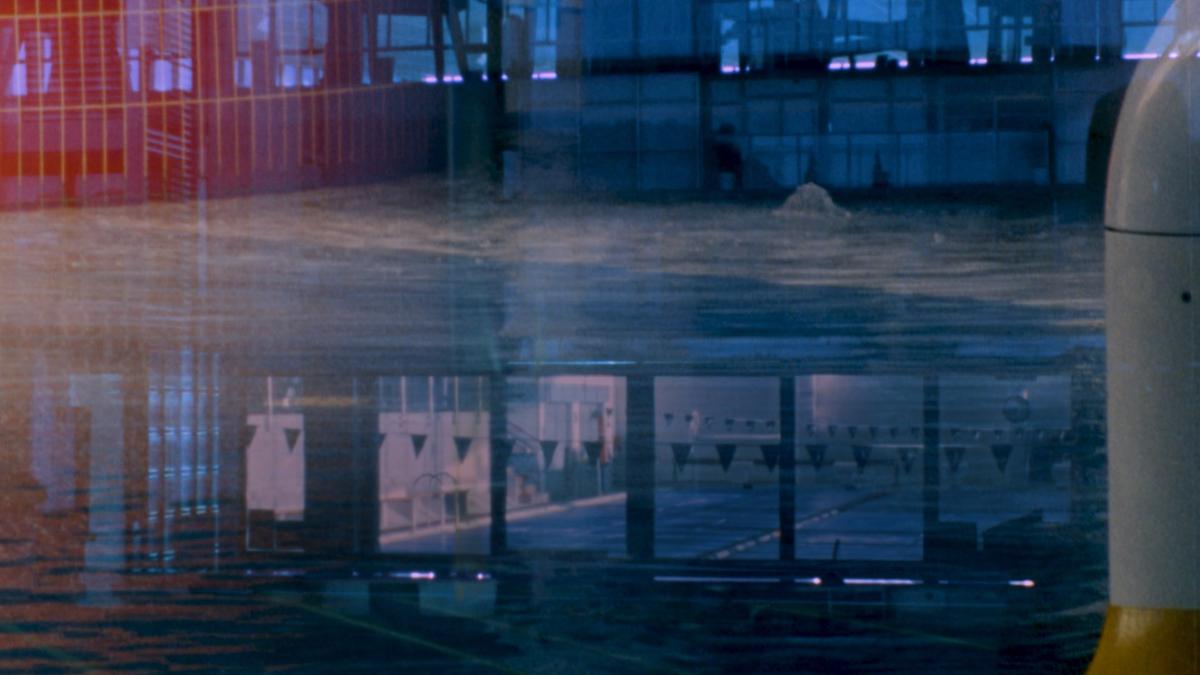It’s a mistake to think of noise as just an excess of information, an overloading of the signal, when it is rather a supplemental background, a diffuse layer upon which information traverses.(1) This notion that noise is a carrier, a compulsive force, no longer a restraint to be overcome, enables it to be understood as a productive paradigm. This is a useful conceit through which to contextualise Sonya Lacey’s practice whose work focuses on the diffuse and yet necessary concomitant layer upon which the textual practices of cultures’ material transmission occurs. Take, for instance, her interest in the font designed by David Kindersley, which is the subject matter of her 2017 works, Infinitesimals and Dilutions, both of which centre around a font that was designed to be read from moving vehicles. Alternatively, look at her more recent interest in the labour force of printing presses, whether it’s the somnolence of that labour in Pillows (2020), or the recreational bathing of Fleet Street’s printers as seen in the shows Literals (2018), and Weekend (2018–2019). All three of these shows share a fascination with the circulatory system of the press itself, focusing on the dispersive effects of textual practices, particularly as these might inflect a secondary conditioning in the persona of the printers themselves.
Throughout this essay I’ll turn to this conscription of noise by Lacey as a positional ploy, one that turns to that reserved suffusion through which the world takes on meaning. For instance, look at her deployment of Muriel Cooper, whose Bauhaus-influenced book design functioned as a steadfast waypoint in the midst of the cacophonous synaesthesia of Lacey’s exhibition Smooth but coarser than yellow (2017). Did that persona not anchor a moment of deliberation that draws together the supplemental quality of these apparatuses, playing up the reserved constituency through which order traverses? This is of course what I mean by Lacey's conscription of noise. Indeed, we might say from the outset that this conscription enacts the very logic it seeks to isolate. That is, this conscription isn’t just an interrogative foil but a paradigmatic act, a necessarily concomitant methodology that draws upon this supplemental space for its potency. In other essays I’ve talked about this reserved site as being a withdrawn condition, a surplus to reality.(2) That is of course Graham Harman’s phrase for reality’s supplement(3), a conception that is defiantly not a passive back drop that exists for the world to annunciate itself upon, but rather, an extensive surfeit which agglomerates actions of every scale.
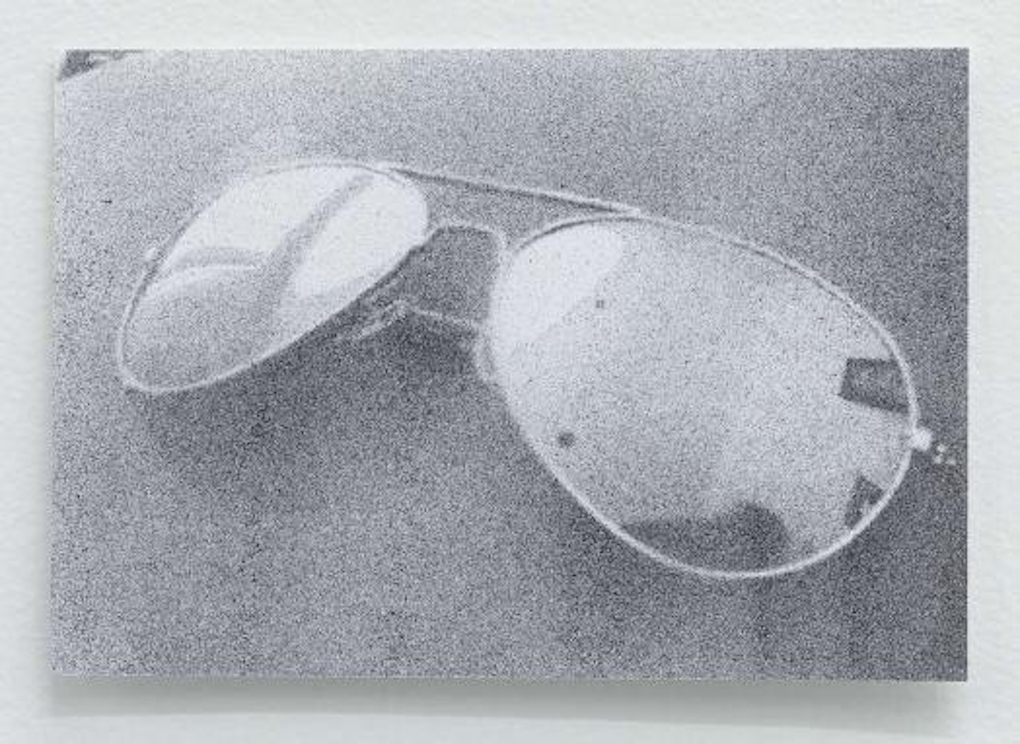
Untitled (airbrush, mirror) (2011) Sonya Lacey
These are after all purposively generic images of sunglasses, sandwiches, t-shirts, shoes, plastic cups, and bottles. The point being the sheer interchange of content, so that we focus not on the subject matter itself but how it takes on form, especially given these pictures’ ether of visibility.
It’s important to register how expansive, both macro or micro, the scale of Harman’s surplus might be. Indeed, it may even be better to think of this surfeit as a poorly demarcated area upon which noise might circulate secondary to immediate needs. Lacey’s ongoing airbrush drawings provide a vivid example of how this surfeit might operate in everyday life. Drawn from a range of images found both online and in print publications, these images are reproduced as muted black and white drawings, that are almost ghostly in intent. Perhaps though it's better to call them tonal, given their suffuse layering of information, their muting of detail, so that the content of the image comes into focus through the sheer brute force of their indeterminate ordinariness. These are after all purposively generic images of sunglasses, sandwiches, t-shirts, shoes, plastic cups, and bottles. The point being the sheer interchange of content, so that we focus not on the subject matter itself but how it takes on form, especially given these pictures’ ether of visibility. As Simon Gennard suggests, “the legibility of these images conceals the unreadable”.(4) That is, the drawings aren’t so much composite images, but articulated substances suffused in noise. They are images that revel in the surfeit layer. They display the compositional substrate of noise as a dense materialist swash through which representational concerns congeal.
Time and again we’ll see Lacey use this conscription of noise to perform a kind of entanglement, an articulation upon which meaning comes to the fore. Indeed, just as the airbrush drawings focus our attention upon the surfeit through which even generic information passes, Lacey’s work excises a paradigmatic act that prolongs our exposure and awareness to this suffuse layer we are all immersed in. Let us start with Lacey’s Infinitesimals, whose very title alerts us to this supplemental and withdrawn surfeit upon which we all depend.
Infinitesimals
Accounting for quantities that are explicitly nonzero and yet smaller in absolute value than any real quantity, infinitesimals are the types of supplements that escape meaning and yet are so necessary to its transmission. This notion of a supplement is crucial to Lacey’s Infinitesimals, a three-channel video work, which imagines a scenario whereby a piece of lead type is diluted and ingested according to homeopathic methods. Comprising video documentation of the foundry where Lacey’s sixty-point metal typeface is being made, another scene in a homeopathic laboratory that follows the distillation and production of the homeopathic remedy drawn from the type face, and a final vignette that documents a joke about the homeopath’s radio which can never not be turned off, Infinitesimals was originally installed in a kind of chamber, in which the three monitors face off against each other, positioned as they were on dual slim metal poles, making the rails eerily reminiscent of the disassembly lines that so inspired Henry Ford’s standardised mass-production. I will return to this orchestration later but for now it’s enough to look to the origins of the typeface in the work.
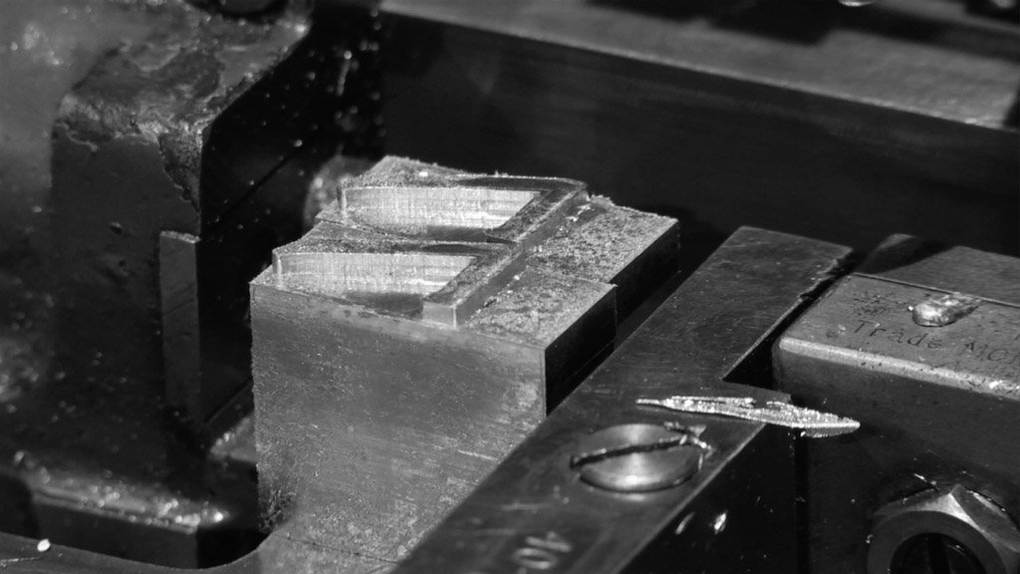
Still from Infinitesimals (2016) Sonya Lacey, 3 channel HD video
The sixty-point metal typeface Lacey commissioned is drawn from an original typography designed by David Kindersley in 1956. Originally composed in response to the increasing speed of automobiles, Kindersley’s font is designed to be legible from a fast-moving vehicle. It is worthwhile then recalling the book Learning from Las Vegas (1972), particularly author’s Venturi and Brown’s focus on a new legibility within the city, one that coheres around the newly organising principle of the automobile. Did they not suggest that the dominance of the moving vehicle caused physical buildings to recede into the background becoming little more than frontages for large symbolic road signage? Is this not the very visage of the strip, that processional line of signage that is designed to be perused at speed? That this has consequences for the city goes without saying, much as the apparatchik of google maps’ blue dot does for today’s urbanism. But what’s important here isn’t the transformation of the city (well, not immediately) but rather the idea of transmission, of a typeface that is designed for legibility at speed. Which is to say that Lacey’s work has to do with digestion. It shifts gears. Not necessarily just bigger, but more legible, more focused, more positioned for a specific reading position.
This domination of the relation is reiterated in the joke Infinitesimals plays up about the homeopath’s radio which “cannot not be turned off”. This double negative allows the radio to take up a position, not just in the corner of the room, but as the only constant in the room. It is always on. Not that this is how it is phrased. It cannot not be turned off. It is specifically taking up a position in relation to what is already happening. It is not just aiming to dominate the relation but to make it systematic. Consequently, the radio defines the laboratory’s orbit. It places everything else into the realm of consistency, turning these intermediaries into satellites, functionaries, missives. In this way, the radio, which, as we learn in the narration, is wiped clean each morning, is not just the piped-in externality of an otherwise hermetic laboratory but an irreducible agent, an object that mediates all those that come into contact with it. Such concerns are directly relatable to the promise of legibility, of transmission, a concern signalled by Lacey’s decision to make a homeopathic remedy from a typeface designed to be read at speed. Which is to say that we are also talking about digestion.
If the radio signs a constant, a double negative, an overdetermined position, it’s well worth placing this alongside Theodor Adorno’s negative dialectics, his insistence that a conceptualisation always omits something, that it never totalises a subject, even an object.(5) Instead, and this is true of any representation, there is always a supplement, not just an outside, nor an excluded, but an active component that is rendered mute. This is what Adorno calls non-identity, a supplemental quality that is felt as a radicalised shadow, a doubt, a negative gap between the object and its sign, the conceptualisation and its unknown. Consequently, Adorno’s response to this supplement is “homeopathic”.(6) That is, like homeopathy in which one takes a dose of the element one seeks a cure from, Adorno similarly seeks redress from this reclusive element of representation by directly engaging with it through a second order reflection. That is, our direct corporeal engagement with any manifestation ought to include a secondary acknowledgement of how these representations incorporate this reclusive, withdrawn non-identity as a crucial component that actively shapes them and our interaction with it.
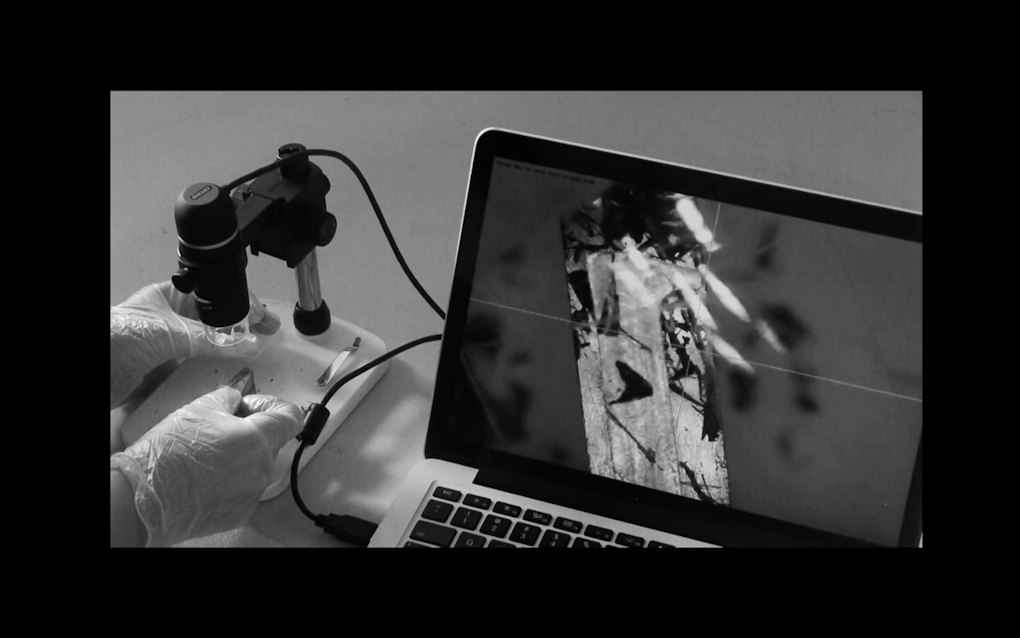
Still from Infinitesimals (2016) Sonya Lacey, 3 channel HD video
Lacey literally puts Adorno’s theory to work, taking not just one of the fundamental means through which we have transcribed the qualitative world to task, but also placing this language into a state of diffusion. This is why she not only commissions a literal, digestible dose, a homeopathic remedy, but also muddles this very real discursive form. This is seen in Infinitesimals’ companion work, Dilutions (the actual commissioned typeface), which Lacey renders in mixture of lead, tin and antimony that is designed to deteriorate, to gradually erode with every pass though the printing press. This is a deliberate perversion of Guttenberg’s original decision to introduce antimony to lead and tin, lending his letter type a durability and clarity that was previously unattainable. Moreover, it is a play upon the homeopathic qualities of antinomy itself which is typically used by homeopaths to treat nostalgia, over-indulgence, and solipsism. It ought not surprise us that Lacey would muddle such an alloy, taking something that has been so historically tuned for clarity and remaking it instead as an entirely conditional, fragile, material artefact. Such procedures not only play up the retro-appeal of letter type, but also conduct that second order reflection Adorno suggests is so necessary to our reckoning with that reclusive withdrawn component of every representation. Indeed, muddling the alloy, allowing it to dissolve with every pass through the press, Lacey concocts a literalised dose, a second order reflection that plays up the historiography of a material culture that encompasses us. In doing so, we can see that Lacey takes up a position, just as the radio takes up a position in the corner of the room, making this specific font, this lexicon of the legible, the supplement, the externality that makes everything else conditional. Indeed, this literalised homeopathic remedy is not just a dose of legibility, but a transmission, an acknowledgement of the gap, of the non-identity embedded within languages’ material condition.
Literally materialising as a homeopathic remedy that would aid our own fluency in the legible, Lacey’s digestive treatment is not just a sampling of the letter type but a transmission, a coursing of that non-objective gap, that second order reflection. As such, Lacey’s use of the homeopathic method holds all sorts of diagrammatic promise, especially given the crucible created by the monitors upon which Infinitesimals originally played. Standing between the monitors we are placed into a disciplinary enfolding, one that recalls not just the flexibility of the letter type, the adjustable rails of a discursive imprint, but also the confessional chamber, the voting booth, the cockpit, the closet… In short anything with a semblance to the disciplinary cradle. Such formative, primal, educational matrixes are entirely fitting for Lacey’s fracturing of language. First into the nostalgic melancholic letter type, a form of communication largely superseded by the cursive reality of binary code. Secondly by its transference to the technocratic sanctuary of the laboratory (does this distillery of essences not treat letter type as an artefact in need of protection? Do we not witness a taking down of its genetic, heritage codes?). And yet such routines also compellingly acknowledge Lacey’s own dissembling mythology, her awareness that language has always already imbibed its own occluded supplement. This is something openly reinforced by the commissioned soundtrack that brackets this cubicle of monitors(7), adding that diffuse texture of noise so elemental to communication theory, in which noise isn’t just an interference, but a necessary component to transmission.
Newspaper for Vignelli
Infinitesimals use of a homeopathic remedy, a literal dosing of the very condition it exposes, shares its methodology with Lacey’s air brush drawings, which similarly expose us to that surfeit of noise through which content takes on form. Such logic was though already evident in Lacey’s Newspaper for Vignelli (2010), a much earlier video work in which she printed Massimo Vignelli's rejected redesign of The European Journal only to film this broadsheet always teetering on the verge of legibility. Perversely, Lacey’s camera seems to track the journal in a tumbling, ambulatory waltz, perpetuating the journal’s visibility as tantalising close and yet constantly just out of focus. As tempting as it might be to read this desultory pacing as a kind of cathartic purging of a lost opportunity, of a journal whose vaunted design principles never came into being, it is far better to recognise the way Lacey once again focuses on the skeletal frame of design as that perfunctory homeopathic dose, that discernible zone of noise in which the infinitesimal aspect of language’s material condition is evident. In recognising this, we might see that Lacey’s work shares similar concerns with other contemporaneous works that are well worth exploring.
Newspaper for Vignelli (2010) Sonya Lacey
This exposure of a skeletal design in Lacey’s Newspaper for Vignelli (2010) similarly abounds in Louise Menzies’ World Edition (2012) which reproduces the front pages of daily newspapers without any text. Called into question by the very absence of information, what Menzies renders is the dormant apparatus of a system that is entirely functionless without its social currency, without the tumultuous story that the newspapers’ language plays host to. Similarly in Nikolas Gambaroff’s Tools for Living (2012), a series of untitled paintings show the generic high-rise city scene surrounded by collaged newspaper fragments. Literally framing the city, these fragments—chopped, ripped, derisively patterned—merge with the city, both overshadowing and supporting it. They are, as Gambaroff’s title alludes, the tools of the city’s living populace. It is, just as the missing text of Menzies’ empty mast heads also suggests, the city’s medium. It's volatile, ripped, fragmentary, gossipy conduit. Entirely at odds with the city’s straight representational proxy, signposted here by the generic images of the high-rise city, it is fitting that this stereotypical rendition would be marooned amidst the viral confluence of language. To borrow Michel de Certeau’s poetic idealisation of an inhabited city, both works by Menzies and Gambaroff point to the “manifold story”, that “forest of gestures” so crucial to de Certeau’s everyday citizenry whose tactics are valorised as the fluid counter-point to the operationally and administrative basis of most cities.(8)
-Nikolas-Gambaroff.-Courtesy-of-the-artist-and-Overduin-&-Co,-Los-Angeles_CIRCUIT.jpg)
Untitled (2012) Nikolas Gambaroff. Courtesy of the artist and Overduin & Co, Los Angeles.
Crucially, what these works of Gambaroff and Menzies point to is the role language takes on within cities’ formations, especially given the suffuse agency through which it shapes populaces, edifices and objects. According to Manuel De Landa we might think of this propensity as language’s viral medium.(9) That is, language charts as a communicable device that courses through populaces as an agent in its own right. Recognised as such, language becomes a propellant of cultures, it shapes and adapts populaces as much as we might think of it as a passive tool we pick up for our own uses. To ignore such agency would be to refuse to see the way technology shapes and adapts, indeed moulds entirely new means through which these discursive refrains find legibility. Indeed, whether it is through the printing press, or the compound materialism of the Dictaphone-typing pool, even the social whirl of the internet-enabled connectivity, language flourishes in a hybrid, techno-human assemblage that will continue shaping us as much as we adjust and adapt to its momentary forms. Which is why Lacey is so happy to film from behind this reproduced journal that never quite materialises, but instead remains elusive, disjointed, always somehow not the object itself, but it’s withdrawn qualification. It is only by the content remaining so elusive that we begin to grasp this wider point.
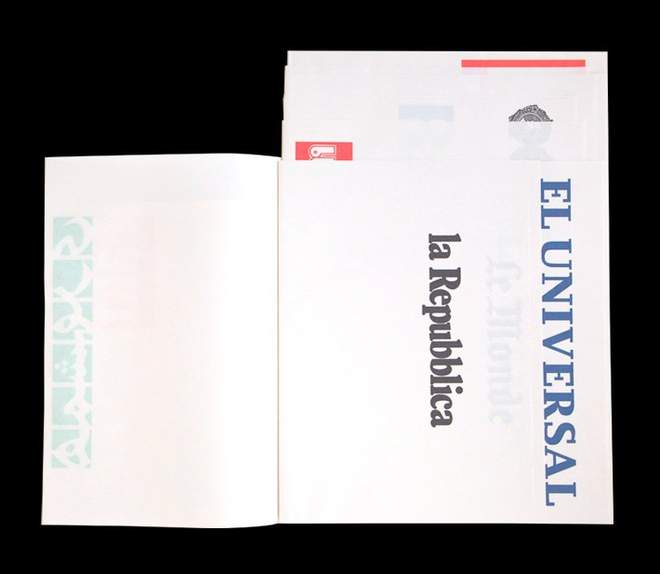
Local Edition (2012) Louise Menzies. Published by the Physics Room and DDMMYY.
Newspaper for Vignelli is an excellent example of the way Lacey orchestrates these second order reflections, exposing not just the skeletal apparatus of cultural transmission but its structural feature within society. As such Lacey provides us with an open acknowledgment of the newspaper as a mechanism through which our material culture coheres. We can however go one step further though and suggest that Lacey’s perpetually out of focus newspaper also grants us a momentary legibility of an occluded supplement that points to a much bigger form. According to Adorno, such supplements exposed a messianic absolute, a melancholic slate that granted a cathartic belief in a world beyond his material existence. For someone like Jane Bennett however, such supplementary forms give over to a vital materialism, in which material and social objects might take on an agency of their own.(10) Both approaches grant these supplemental forms a material quality that enriches experiences, just as it does in Lacey’s practice. Indeed, we can point to a cathartic melancholia involved in Lacey’s charting of the material condition of language, whether that’s her treatment of the metal font in Infinitesimals or the spectral ambulatory tone of Newspaper for Vignelli. Both treatments produce a ghostly vapour in which the supplemental quality exposes us to that surfeit of noise through which meaning coheres. Equally though we can say Lacey grants her subjects an agency that is buoyant if not charismatically infectious, granting us access to the material peculiarities through which these withdrawn qualities enable us to draw connections across multiple scales.
Smooth but coarser than yellow
Lacey returns to the issue of legibility with a suite of small brass miniatures in 2017 that replicate the page layouts of the Bauhaus influenced designer Muriel Cooper. Appointed in 1967 as the Design Director of MIT Press, Cooper published over 500 books during her tenure that popularised the modernist notoriety of Swiss typography and the grid system page layout. It is this grid page layout that Lacey replicates, albeit without content, as small twenty-centimetre brass sculptures that sit on small plinths. This plinth-like quality means the sculptures read like small headstones, giving them a desultory tone, much as the tumbling motion of Lacey’s Newspaper for Vignelli similarly intended. However, like Menzies’ absent newspaper layouts, we can see that Lacey’s brass miniatures do not actually commiserate anything but instead highlight the very framework through which languages’ viral confluence is granted clarity. Skeletal in intent, they lay bare the format of a design principle which prioritises the delivery of content. This was perhaps more obvious given the chaotic context in which these sculptures appeared, positioned as they were in the midst of the cacophonous swirl of Lacey’s exhibition, Smooth but coarser than yellow (2017) which didn’t just allude to synaesthesia so much as conduct an overwhelming commingling of the senses, so that the idea of a colour taking on a consistency of touch opened out onto the surfeit of content through which Lacey structures so much of her work.
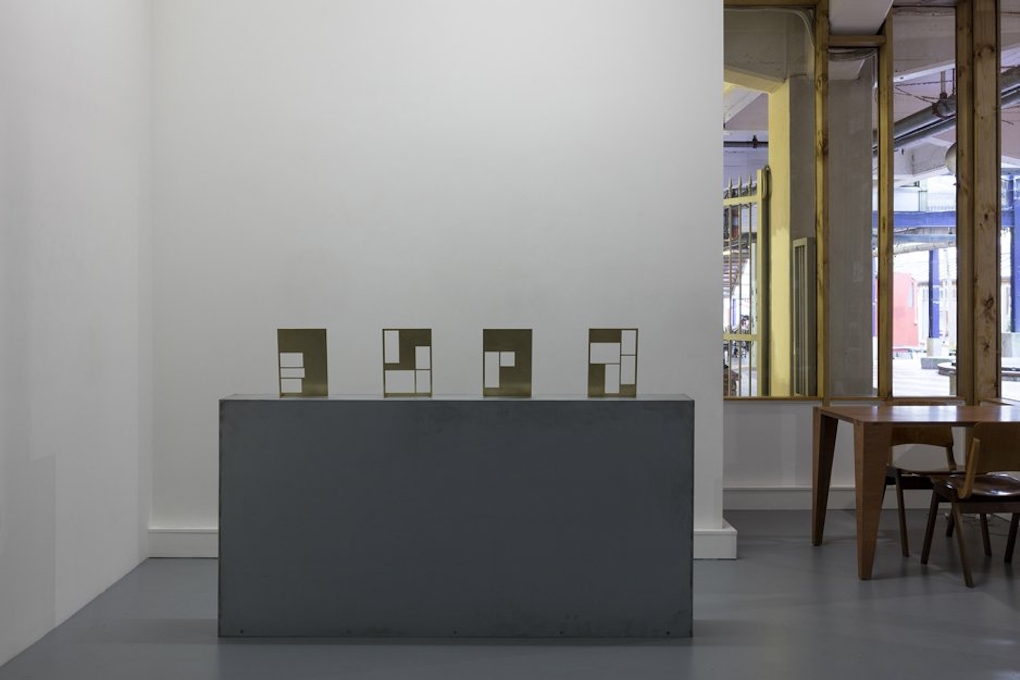
Installation view: Sonya Lacey, Smooth but coarser than yellow (2017). Courtesy of the artist and Robert Heald Gallery.
Smooth but coarser than yellow’s centrepiece was a dual overlapping video projection that traversed a kind of canonical history of page design, submitting the viewer to an overwhelming diversion of imagistic refrains. Purportedly an historical overview, Lacey fragmented a story of design taken directly from books and catalogues. You stood then amongst an array of signs made into signs, of images which had been set into perpetual motion. In fact, Lacey allows the layouts to continuously bleed together, leaving us with the afterburn of the palimpsestic process. In this way history blurs. Its deviations repeat in the isolated images that are then treated to various diversions, whether imploding as spirals, dispersing as pixelated flows, or meandering in concentric lines. This is a profligate treatment of content, so much so that what you experience is instead a general malaise, a funk of information overload.
It may be better to describe Smooth but coarser than yellow as an echo chamber, a dalliance with commingled senses. It is often said that all of Michel Serres’ books might be written as a philosophy of the commingled body.(11) Of the senses united to make a sapid human, one no longer dominated by languages’ routines, by cultures’ saturation of the thinking body, of the indoctrinated body, of the interpolated mind. And yet nothing eclipses that economy which so preconditions us, which so bifurcates even our best of intentions. No wonder that you stand in a room full of fragments, of images which constantly overlap and bleed into another, just as Lacey’s dual screens similarly replicate the process. It is palimpsestic, but it is also method. There is a clarity of the image, and then a mutating of the senses. Even though so much of Lacey’s work derives or points to another thing, the purpose is never pure similarity but the mechanism through which it works. After all, even though it may be smooth but coarser than yellow, we still never know what it actually is! It’s just not yellow. Such elusiveness is the homeopathic treatment.
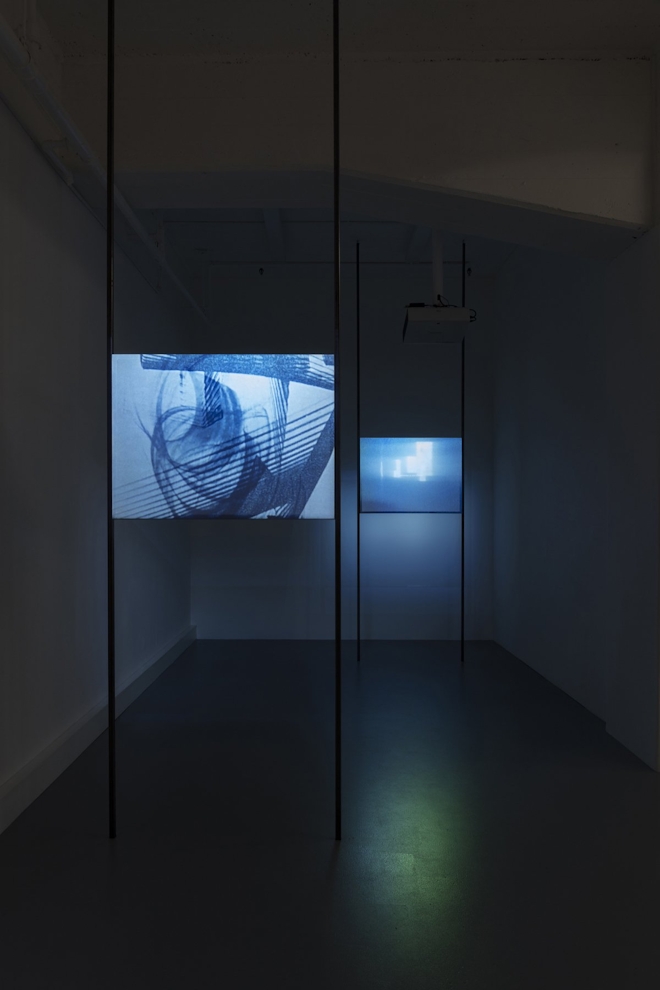
Installation view, Smooth but coarser than yellow (2017) Sonya Lacey, 2 channel digital video from super 8mm film. Courtesy of the artist and Robert Heald Gallery, Wellington.
Lacey’s exhibition title purposively derives. Something is determined by its relation. This is an entirely familiar tactic. Just think of the way Infinitesimals revolves around its absent referents. As I have said, what such derivation alerts us to is the supplemental background, that withdrawn and yet necessarily surfeit through which life takes on meaning. Like so much of Lacey’s practice, this is a paradigmatic act that highlights the idea of transmission, of being receptive to transmission, so that one takes up a specific disposition in relation to it. This is how Lacey shapes a model of attunement. She makes us receptive to what is already in play. Her use of synaesthetic form, that condition in which there is a mingling of the senses so that a colour may be felt as textural substance, or a piece of music heard as a culinary taste, is an extension of this derivation. Nothing signals this better than the moment in Smooth but coarser than yellow when Lacey stops the ambulatory cohesiveness of the films’ melancholic atmosphere, only to make a joke about the “preponderance of simile”, going on to itemise all those moments in which this is like that.
In the midst of this saturated environment Lacey’s Muriel Cooper sculptures function as anchors. Positioned off to the side on a waist-high metal plinth, they are waystations of clarity. And yet, they are entirely absent of content. They are the scaffolding. The frame. The very method of delivery. They function much like Fiona Connor’s abandoned newspaper stands. They are dormant mechanisms. They reside outside of circulation and yet are central to it.
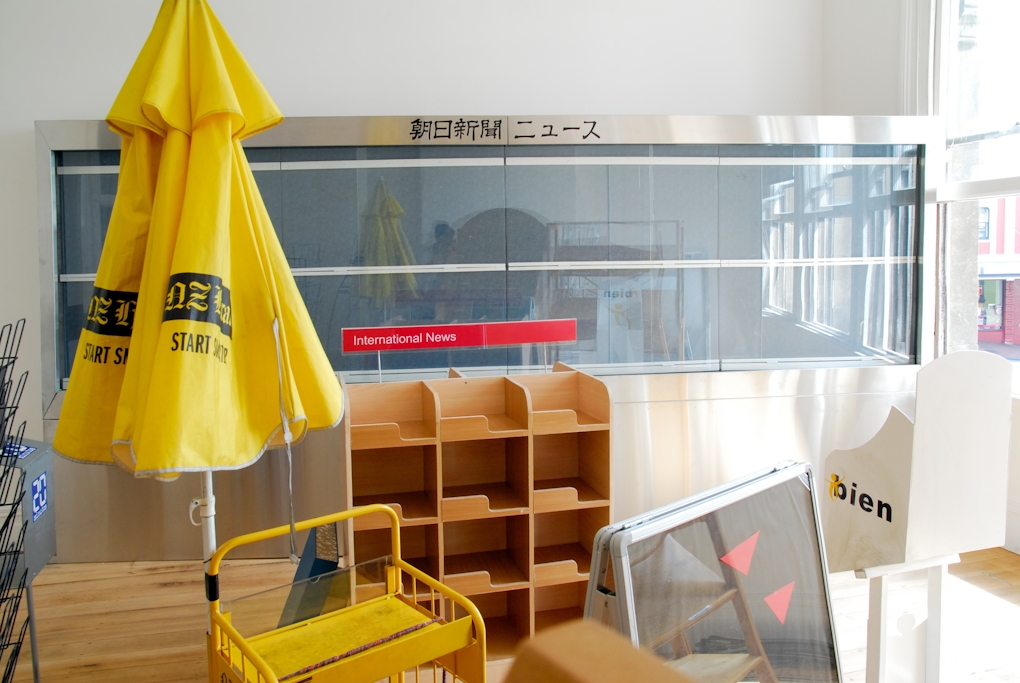
Installation view, Notes on Half the Page (2009) Fiona Connor. Photographer: Alex North. Courtesy of the artist and Coastal Signs.
This exposure to the skeletal frame is an immersive surfeit. It is, as the cacophonous swirl of Smooth but coarser than yellow requires, the homeopathic dose that might wake us from this overloading of the signal. The liberating tonic of this dormant mechanism acts not so much as a consolatory device but a provocation, a bared mechanism that shows up not so much the way surfeit works but how central it is to our lives. Perhaps then we might call this kind of immersion a textural coarseness that awakens us to a sense of touch, dare I say of a transmission that begins to rekindle mediation with the world. Indeed, what Lacey has in mind is a kind of synaesthesia of the fold, an awakening of the habituating instinct whose rekindling of the dwelling instinct might be better described as an arousal of the sapidity that makes us human. Which is, in a roundabout way, what synaesthesia does. It takes some sense and makes it another. Makes a home from one instant and tropes it, spins it into another web of feeling, of likeness. To trope is to turn, to turn topos on its head. To spin it around. To mix. Which is precisely what Smooth but coarser than yellow does.
Soft pollution
It’s no surprise that Lacey’s preoccupations with noise as information’s surfeit, its congruent layer, comes to a head in the suffusion of information that overrides Smooth but coarser than yellow. In Michel Serres’ terminology this overproduction or overwriting of the material world is a form of soft pollution, a disturbing layer that distorts any form of sensation, muting the sapidity through which we might build up meaning.(12) Paradoxically this muting is the perturbing consequences of our ability to write the world up in the first place, to mark it into meaning, taking the soft materiality of what we encounter and turning it into hard material objects. To enclose the world like this, to deliberate it, paradoxically closes us off to it. Look for instance at what Serres suggests becomes of the writer who guards and dishes out words:
Death turns us into words, words turn us into dead people. An epitaph-sentence under which things are buried. Those who deal with words deal with the dead and like to look as though mourning for the world. From the time we are baptized, our names seek a formless immortality, a gentle trace that will linger after our disappearance. In death we are reduced to our name alone, fragile, weightless, fleeting, defenceless, covered over by the customary handful of dirt.(13)
It is then a paradoxical endeavour to inscribe the world with meaning. Not only does such ascription weigh us down, but it delimits our possibilities. At best, it is a fleeting, defenceless, and fragile charade. At worst, it is an exhaustive refrain, a self-perpetuating delusion that pollutes the world. Such exhaustion at least highlights the underlying current, that surfeit Lacey focuses upon which so underwrites noise as a marginality we ought to be listening to.
For Serres there is a kind of musicality to noise, one that underwrites production. To be clear what Serres isn’t proposing is that familiar dichotomy, promulgating noise as bad, silence as good, but rather a mixture of soft and hard pollutions, of inscription and free form materiality. As he suggests: “language speaks, gives us gently meaning, proves, but also blows, thunders and shreds us with its screeching”.(14) It is then a give and take, a kind of refuge in which we might learn to tell the difference in what we are doing. Touch is, after all, in Serres’ terminology, “topological”.(15) That is, encounters are marked by a sensorial encapsulation. It is multivalent and entirely optional. It is an articulation that inflects all participants. Which is to say that the topological encounter is a material gain, an inscription of the world that is much more reflexive to the infinitesimal aspects of our fleeting and momentary interchanges. As we have seen, Lacey is particularly attuned to this encounter, especially given her focus on the mediums through which language fluctuates, particularly as these have related to the fonts and page designs of the iconic designers David Kindersley, Massimo Vignelli, and Muriel Cooper.
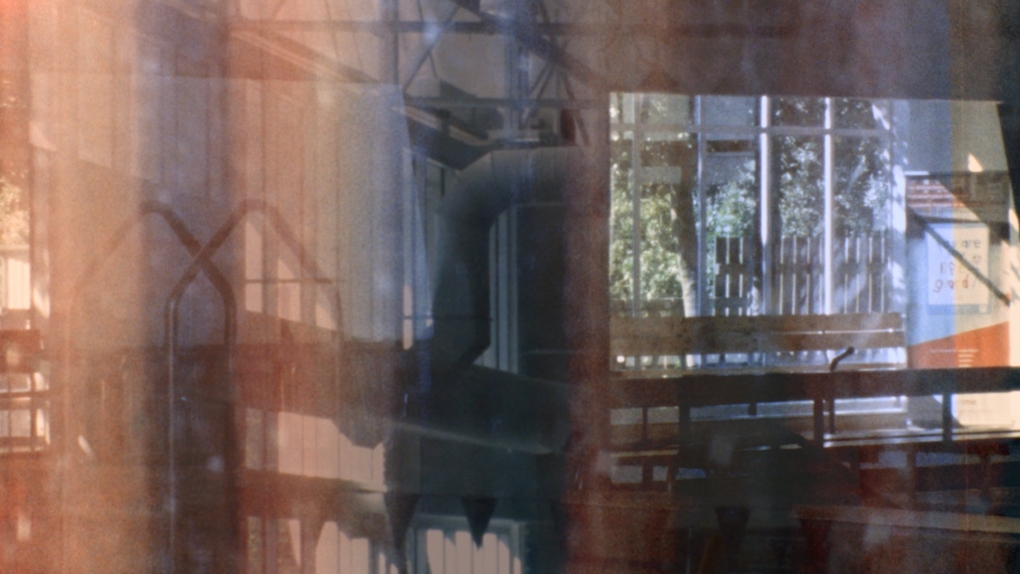
Still from Dissolves (2020) Sonya Lacey, 4 channel HD video from 16mm film.
The creaturely
The laconic aspect of a materiality that eludes the soft/hard binary of inscription as a type of musicality is, as I have discussed, lucidly present in Lacey’s drawings of everyday objects. The ethereal quality those drawings share promulgates the admixtures through which distinctions are topologically felt rather than prescriptively named. Little wonder then that Lacey’s work would run aground on the harsh realities of over-inscription in her focus on the material condition of written communication, retreating into an exhausted refrain through which we might seek a kind of refuge. As Serres makes clear, it is only through such refuge that we might begin to understand just how much sensation regulates a topological exchange that doesn’t delimit the world through inscription but opens it up to connections previously thought impossible. This is of course a very common strategy within contemporary art, particularly prominent within painting. In fact, as I’ve written elsewhere, Richard Bryant’s nest-like paintings provide a vivid example of this type of sensorial retreat, especially given his radical charting of the territorial impulse as a multi-dimensional activity.(16) Such attributions also surface in Lacey’s Newspaper (for bathers, before work / after work) (2018) a moving image work that moves with a glacial, geological pace. That is, the work moves with a sense of momentum that is at once exhausted, and yet entirely reticent, almost autonomously so.
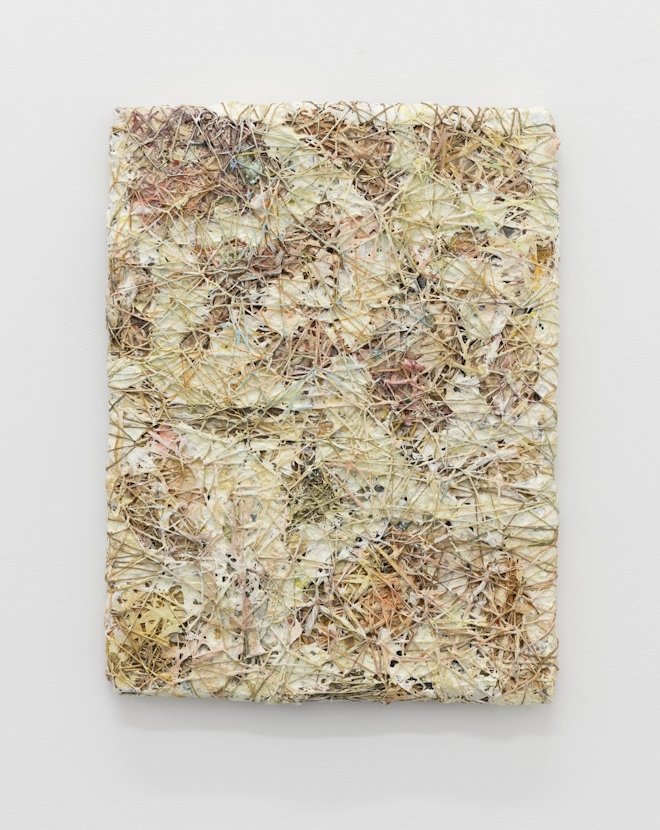
Paw (2016) Richard Bryant, acrylic on fabric, twine. Courtesy of the artist and Robert Heald Gallery, Wellington.
Newspaper (for bathers, before work / after work) is a suite of digitised collages that scroll horizontally across three screens on a large wall. Initially taken from the colour photographs that run in the daily newspapers, those images are bled and drained of their content. They are literally exhausted images, overly so. Lacey has blurred any visuality from their once precisely defined inscriptions making them instead soft monochromatic washes that mimic the soft bulbous contours of Hans Arps. They are, if you will, drained images and yet they are saturated with content. They are at once the soft pollution that overwrites everything and at-the-same-time the subtle musicality of a topology of content. Which is to say they are combined, comingled content, contiguous surfaces that are alert to that sensory touch Serres suggests is so central to a multivalent present. Which is why the digitised collages drift so slowly by, not with the frenetic scroll of social media but the glacial pace of rock formations. They are, just as Bryant’s paintings also are, territorial refrains, they take the frame from which art generates its impulse and turn it loose as a sensory invocation that “captures something of the vibratory structure of matter itself”.(17)
What Bryant and Lacey share here, is a concern with the creaturely, that term Hal Foster uses to describe the preoccupations of post-war artists like Jean Dubuffet, Eduardo Paolozzi, and Asger Jorn. Linking the gestural proto-human like degeneration of those artists exhausted figuration with more recent theoretical work around the bio-political apparatus of the modern juridical subject by Eric Santner and Giorgio Agamben, Foster suggests that the creaturely is a foundational form that rescues the over-determination of the human as a political subject prey to the whims of totalitarian violence and capitalist expansion. As Foster suggests “the eruption of the creaturely in art or literature signals a desecration in the human order, a crisis in which life appears abandoned”, but only because such “exposure” is “revelatory”, demonstrating how much the modern judicial era relies on the biopolitical definition of the human. As Foster writes:
Such penetration is obscene, to be sure, but in its very deformation of the subject it can also be revelatory, for power is revealed in this exposure and potentially it is revealed as groundless (or at least not grounded in justice). Unlike the beast, the creaturely is not the double of the sovereign so much as the object-turned-witness of its violence. There is a political knowledge to be gained here, and, paradoxically, perhaps a revolutionary delight as well.(18)
Of course, Lacey and Bryant are not this overtly political, nor are they concerned with an explicitly human subject as Foster is. However, this preoccupation with the creaturely as a proto entity shares a number of conceits with Lacey’s focus on material culture’s surfeit as a supplemental foundation that affords a second order reflection that similarly exposes penetrations that come to overdetermine our encounters. In this register, the creaturely is precisely that arousal of sapidity Lacey so invokes, particularly in the scrolling digitised collages of Newspaper (for bathers, Weekend), which given the geological pace with which it moves, is better thought of as a topological encounter that triggers a cathartic awakening of the viewer.
Second class bathing
Newspaper (for bathers, before work / after work) is part of a suite of works Lacey has created around a Victorian-era swimming pool that was used by employees from the nearby newspaper printing industry on Fleet Street. Established in 1891, the pool provided an opportune site of relaxation for overstressed workers. However, by the late 1960s, gentrification had long shifted the actual printing of newspapers to the outskirts of London and the pool sat dormant until it was covered and turned into the Bridewell Theatre in 1994, much like the similar repurposing of the Blue Baths in Rotorua. Now, fittingly repurposed again, (as the St Bride Foundation, an archive for graphic design and publishing), Lacey’s opportune documentation of the original pool tiles, barely visible from the Foundation’s basement, provides the basis for a suite of work that was shown at Literals (Robert Heald, 2018) and Weekend (Dowse, 2018-2019).
Sonya Lacey, Weekend (installation documentation), 2018.
This context grants the dilution of the creaturely images in Newspaper (for bathers, before work / after work) a different kind of energy. If previously the images invoked the overwriting of soft pollution as an exhausted creaturely conceit, this context amplifies the dilution and merging of content in the collages themselves, just as the St Bride’s pool would have swirled the ink of the newspaper’s printers as they swam in it. There’s a kind of cycle alluded to here, taking its nadir as an anonymised mass of expended ink, the soupy indeterminacy of the creaturely collages mimicking the exhaustion of the workers who sought solace in the pool. The foundation was, after all, a therapeutic if not sanitary conceit concerned with the printers’ welfare. The pinnacle then is of course the actual news, as individuated, discernible content but once again Lacey paces that second order reflection, focusing less on the mechanisations of the actual news, than the noise of the apparatus itself. Which is I think why she focuses here not on individuated icons of design as she has before but instead the anonymous workers, literally pooled in a secondary, fragmentary way, alluded to, after the fact, as a contextual link for the soupy concatenations of her creaturely abstractions. However, we can also see that this secondary concern is a capturing of the mass subject, that secondary anonymity that Andy Warhol was drawn to as well. As Hal Foster has pointed out, Warhol’s fixation with celebrity and disaster was a consequence of “the society of the spectacle” in which “the mass subject often only appears as an effect of the mass media”.(19) For Warhol this mass subjectivity found its expression in the banality of notoriety, that fifteen minutes of fame which deigned to flatten everyone into a horizontal structure, but in Lacey’s hand this anonymity turns away from the hubris of human desire, instead literally pooling the human as one component among many invoking what James Lovelock would call a super-organism.
As Lovelock points out, cities can be conceived as nests in which 90 percent of human populations congregate as the spatial requirement of a communal evolutionary decree authored not by any one particular human but as an expression of Gaian hypothesis that disperses evolutionary conceits across multiple actors.(20) Whilst not wholly aligned with what is at times considered fringe bio-sciences, Lacey’s secondary reflections on the mechanisations of printed language, particularly as these reflect back on the viral communal flex of language as a participant in culture, one using humans as a vocalising form, links her work to this communalised organism that operates across multiple life forms. At the very least she implicates the mass subject that Andy Warhol so aroused, as a participant not wholly conscious of how much their desires are subsumed by grander designs. As I’ve suggested, it takes the exposure of the creaturely, that residual awakening of a sapidity from within the overwriting of soft pollution to see this, but as should be clear by now, these creaturely forms Lacey enunciates so well, point precisely to this kind of communal organism. This is perhaps more obvious in connection to the accompanying publication Lacey made for Newspaper (for bathers, before work / after work) which documents the tiles of the actual pool still visible below the basement of the St Bide foundation today.
Sonya Lacey, Weekend (installation documentation), 2018.
Lacey’s title for this publication, Second class bathing, doesn’t mince words. It is of course reflective of the lowly status of the printer, one who needed a paternalistic and charitable organisation to care for the body of its labour. And yet, Lacey’s title also points to the secondary component of a long chain of connection through which material culture achieves transmission. After all, Fleet Street has long been synonymous with the business of journalism, and yet, who thinks of the printers who would have comprised the bulk of a newspaper’s labour force? This isn’t just second class as entirely secondary, after the fact. Worse yet, think how lowly the newspapers' distributers must feel, those packing the papers into trucks, hauling stacks onto shelves, hawking them about town. These agents literally come after the fact and yet how crucial they are to the journalism assemblage. We need only return to Fiona Connor’s newspaper stands to recognise just how much extended labour is involved in the assemblage of a journalism, that form of dispersion that Fleet Street is so synonymous with.
If Lacey’s work around Fleet Street’s swimming pool refracts this dispersed assemblage, we can see in her exhibition Pillows (2020) a similar exposure of the creaturely that points to this comingled apparatus, this time in a hypnogogic register. Made infamous as a term for a genre of music that privileges a melodic nostalgia buffered by the attenuating pressures of noise, the appeal of the hypnagogic relies entirely on this perpetuated and meandering tension that repels and attracts the listener. This onus of discernment is the perfect parallel for Lacey’s Pillows, a kind of ode to the Cambodian printing press worker she filmed asleep upon a thick pile of freshly printed material. Not that he ever actually appears in the film. He is, as should be no surprise, another of Lacey’s absent referents. In this instance, Lacey’s film was accidentally exposed during a customs’ inspection, leaving Pillows to become an imagistic refrain to the sleeping insolence of the printer. As Simon Palenski suggests, “Pillows is a kind of dream sequence, a picture of the napping man’s dream at work, where the currents of his day-to-day job have entered his dreams”.(21)
“Currents” is the perfect description for the way Lacey imagines labour processes, not as the cognitive labour of any one individual but rather the anonymised persuasion of an agentic assemblage. Note how the film is buffered by the fragments of the work-place: cooling fans, paper strewn desks, calendars, thin curtains, hanging displays of books, all those nonhuman agents that compose and intrude upon the hypnogogic dalliance of the worker’s sleep. Should it be any wonder then that Lacey takes such subject matter as the basis for abstractions that constantly take on a creaturely mildew feeling. Are they not after all the bitter remnants of a soupy concatenation that spread all around us?
Bathers
Filmed during April’s Covid-19 lockdown, Lacey’s Obstructions (2020) and Dissolves (2020) capture the public swimming pools of Wellington (Freyberg, Karori, Tawa and Kilbirnie) from a range of vantage points that look in from the exterior of these pools. In the four-channel work Dissolves, an incremental editorial dissolve is continually enacted on each frame so that bands of colour slowly appear across each image. As Stephen Cleland suggests, “each image is bathed in morning light, yet the unique combination of tones generated by the layering of transparent images introduces a toxic palette of colours which hints at the threat of contamination”.(22) In contrast, the two-channel work Obstructions mechanically tracks static frames, mimicking the surveillance of a telescopic lens. It reinforces the obstruction of the architecture which continually impedes and frames Lacey’s point of view, isolating the pools as a space separated purposively from us.
This distanciation is, as we have seen before, a dispersive tactic. It holds the pools at a remove from us, introducing the inevitable mechanics of Lacey’s use of simile. Conversely though, the pools have, as we have seen before, functioned quite differently in Lacey’s practice. For instance, in the Fleet Street works swimming pools promulgate the anonymised condition of the social body as an assemblage made of many parts at multiple scales. Paradoxically then, the pool in Bathers specifically excludes its participants. Perhaps then it’s better to look to the human here as another of Lacey’s familiar absent referents. As such, the pools become dormant, skeletal in the same way that Lacey’s Muriel Cooper sculptures were absent of language. After all, if the Cooper sculptures brought into relief the frame of languages’ viral confluence, then perhaps the pools’ absence of humans expose a different sort of frame?
There’s no doubt that Bathers are conspicuously absent of their human populations. They are eerily deserted scenes, ones we have all become inured to given their familiarity during April’s lockdown. And yet it’s a mistake to read Lacey’s works as just another a retort to that familiar banality, for they probe that absent referent in order to expose the format that sustains it. That is, the empty swimming pools may be absent of their protagonists but they are not stilled bodies of water. They are, as Lacey keenly highlights, closely attenuated systems, mechanisms that need to be plugged into an array of ventilations just to keep them running. Could we not then call these empty swimming pools congruent bodies? Do they not wait patiently for the connection to resume? No wonder then that Lacey would shift from the wipe which featured so heavily in the Fleet Street works in which the fragments would morph across the screen, to treat these empty swimming pools instead to a series of dissolves, allowing these contiguous bodies to switch in and out of focus. Do they not then become less apparitions but dissolutions of the body, of the apparatus that almost requires us to participate? Without its human populations might the pool be entirely superfluous?
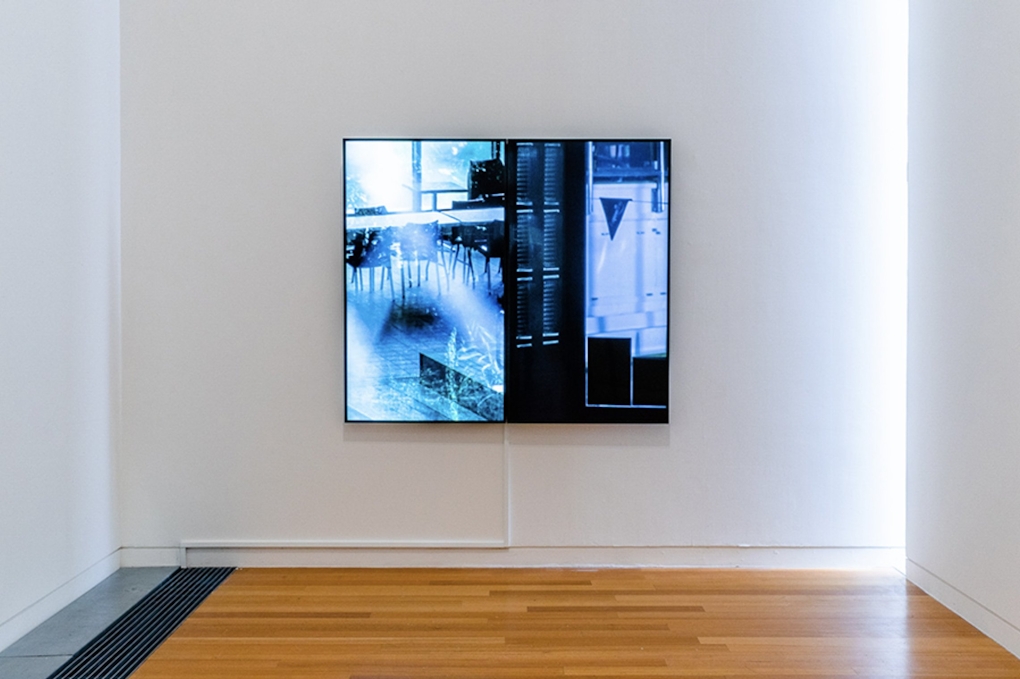
Sonya Lacey, Obstructions, 2020, installation view of Crossings (a group show about intimacies and distances), Adam Art Gallery Te Pātaka Toi, Wellington, 2021. Photo courtesy Adam Art Galler
It's useful here to recall Giorgio Agamben’s maxim that the care of the populace becomes a social polity of management. A policing of the body as much as it is a promotion of a healthy reflexive citizenry.(23) No doubt such invocations are maximised by the health emergency context of Bathers, particularly given the daily appearance of our Director-General of Health in an officiating capacity, but that doesn’t lessen the insidious context of Lacey’s manipulation of the generically anonymised framing of the emptied pools. Perhaps then it's better to say that Lacey’s focus on these empty swimming pools calls up not just what’s absent but the social polity that embraces the swimming pool in the first place. There is then a huge emphasis here on the structural needs of actual bodies not just as docile subjects of control, but as manipulatable content. Such context explains why Lacey’s Pillows was so drawn to the insolence of the Cambodian worker whose refusal of work becomes a kind of noise within the system. Similarly, we ought to see that the various dissolutions Lacey employs in Bathers functions as disruptions that begin to sketch a kind of scaffolding of the city. Indeed, if we follow the line of reasoning through which Lacey appropriates a mass subject as a horizontal actant within an assemblage, then we can see that Bathers heaves with a creaturely conceit that moves beyond the purely human to become an expression of the city, much as we have similarly seen Lacey mould humans into vocalisation devices through which the viral currents of language find expression.
As I said, Lacey’s methodology relies heavily on a conscription of noise as a device that not only exposes the creaturely but flattens the human into one agent among many. Nowhere is this more evident than in Newspaper (for bathers, before work / after work) where Lacey’s filmic treatment, those geologically paced wipes, generate that suffuse layer through which we extrapolate a social scaffolding of labour, particularly as this might relate to the agential assemblage of anonymised subjects. We can see then that Lacey’s Bathers points again to this notion of a scaffolding that encumbers the human in an assemblage larger than itself. As such it ought to be enough that Lacey’s creaturely conceits constantly show up the utter senselessness of human cognitive hubris, especially as this relates to that shadowy alterity through which so much of meaning coheres. That is, Lacey’s preoccupation with the surfeit through which material culture manifests itself enables us to see just how valuable this contiguous “out-side” is. However, as we have seen, Lacey’s probing of the surfeit as a carrier of information not only demonstrates the vitality of this field but how it also involves us in assemblages that eclipse purely human intentions. As such, Lacey’s exposure of the creaturely, particularly as a response to the exhaustion of soft pollution, provides the kind of topologically encounters that enrich our understanding of the world. Moving beyond the purely prescriptive transcription of an objectified world Lacey’s practice instead enables us to see the very frame of our sensory and haptic entanglement through which the “world becomes more highly differentiated as understanding proceeds”.(24)
